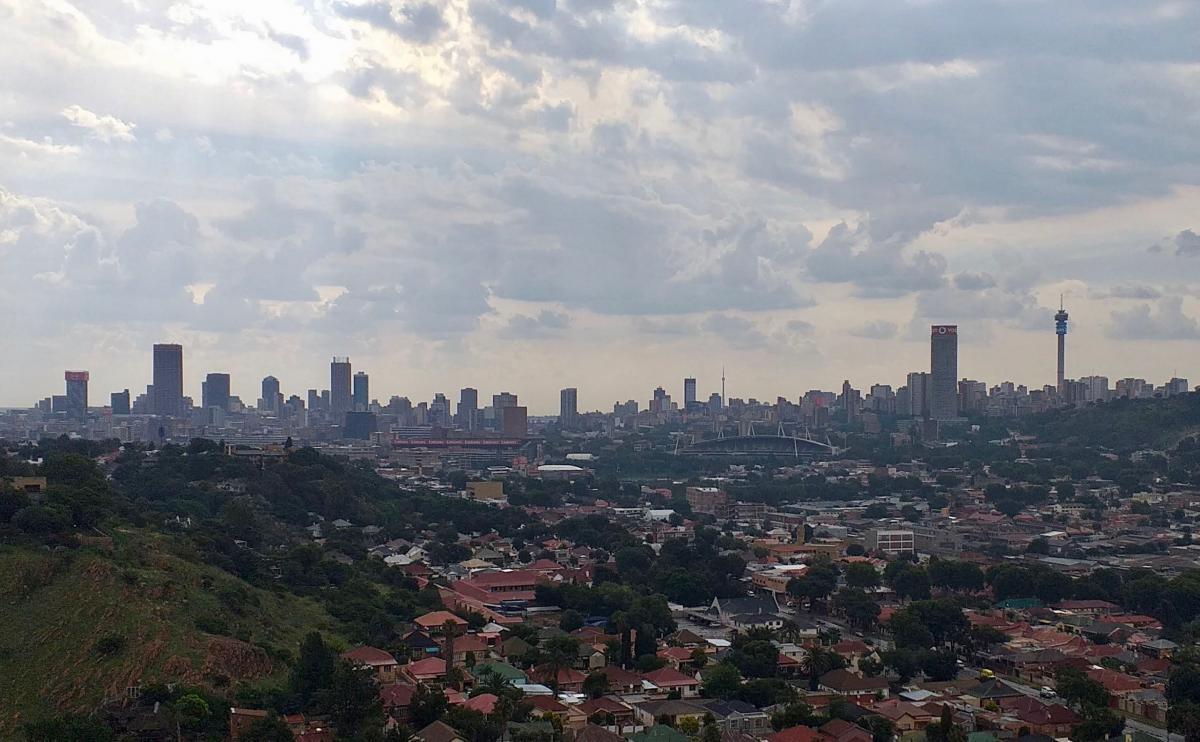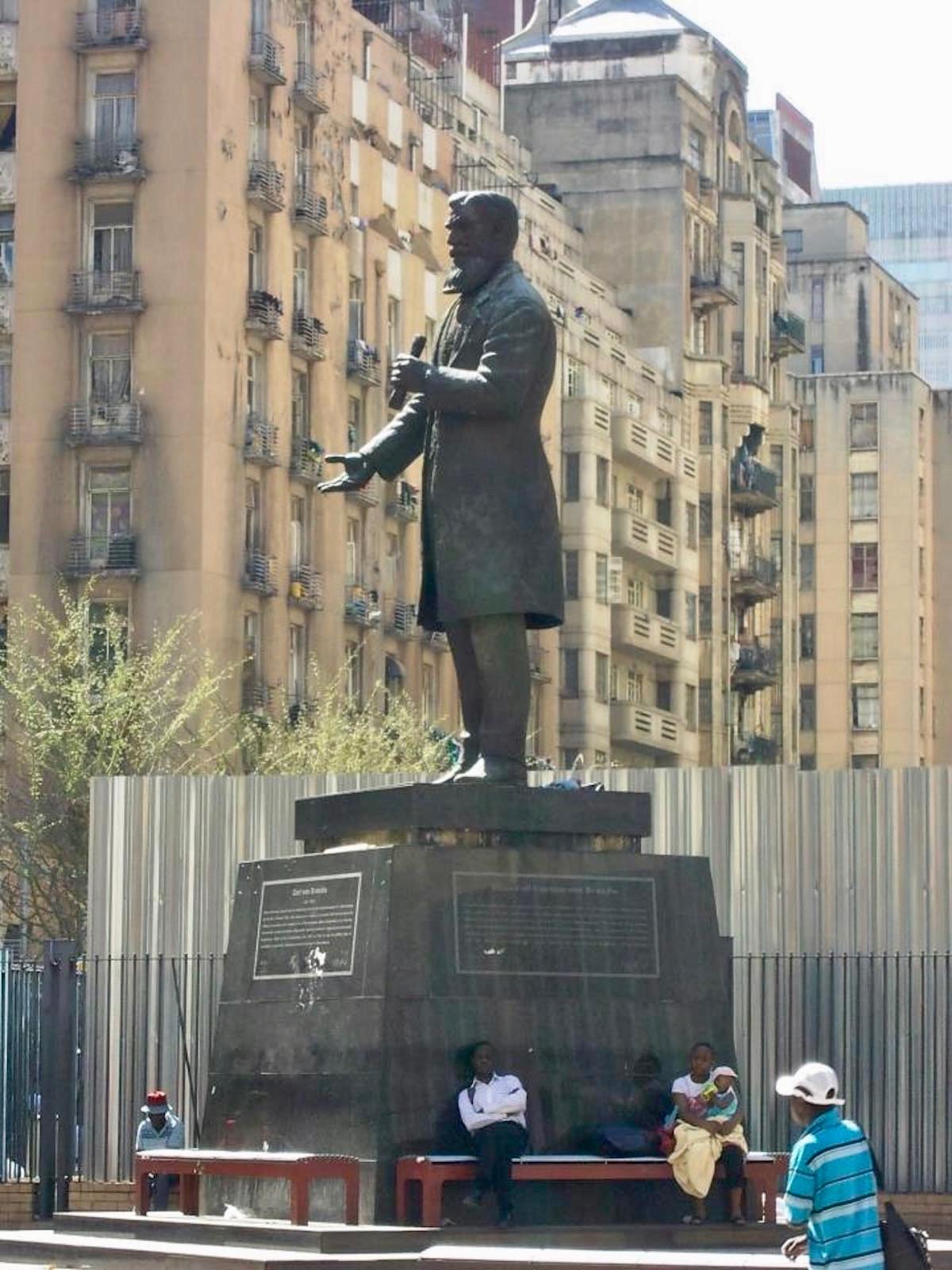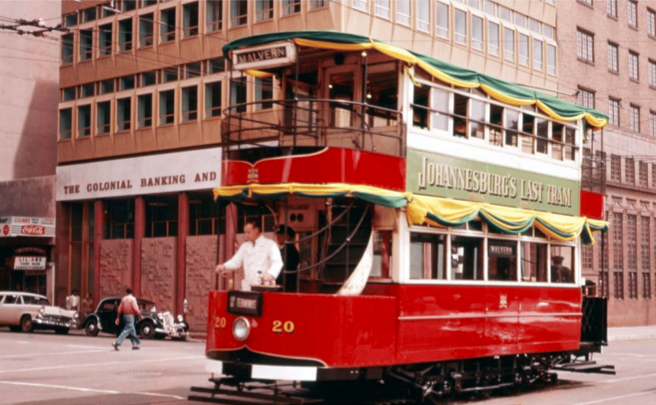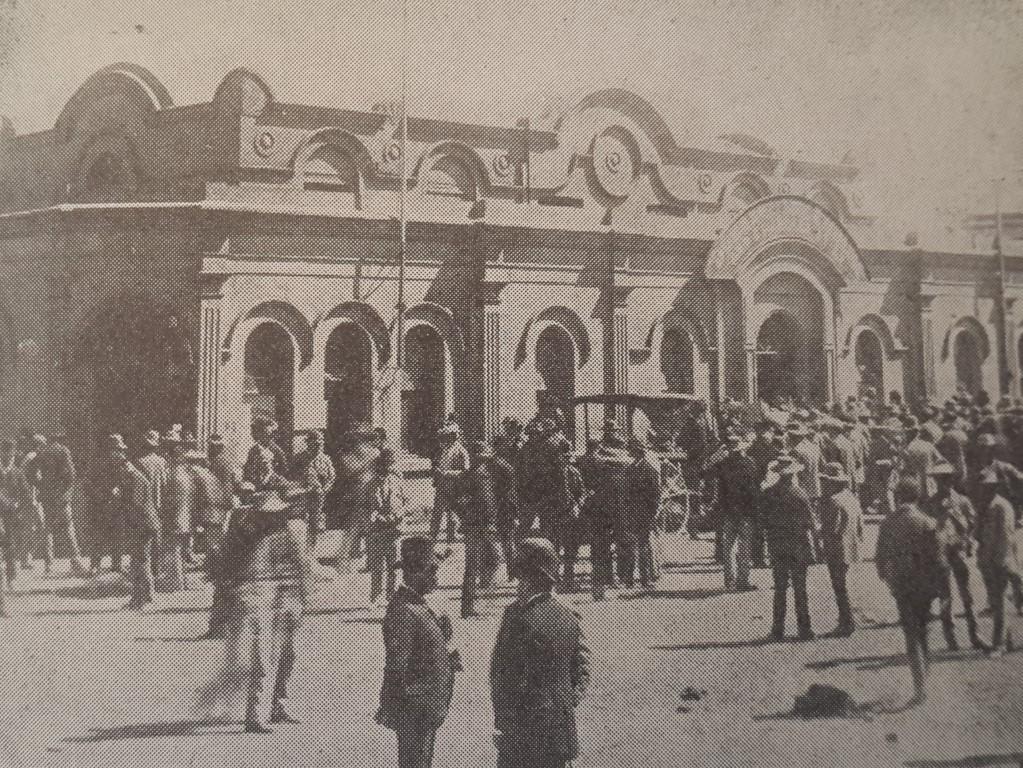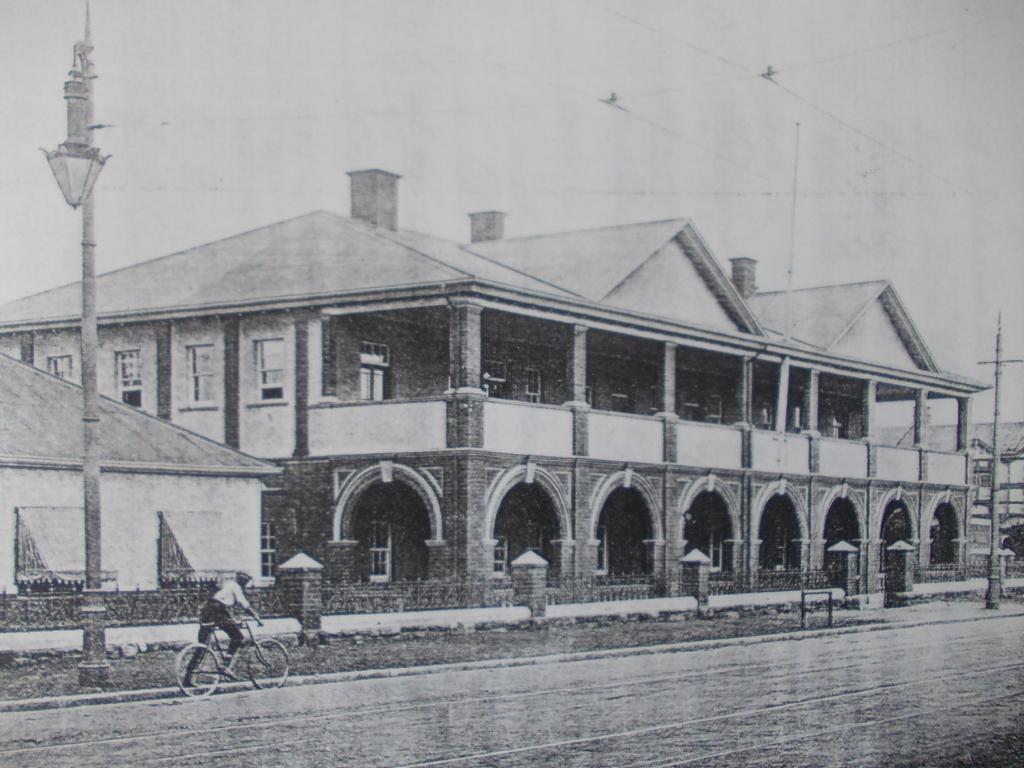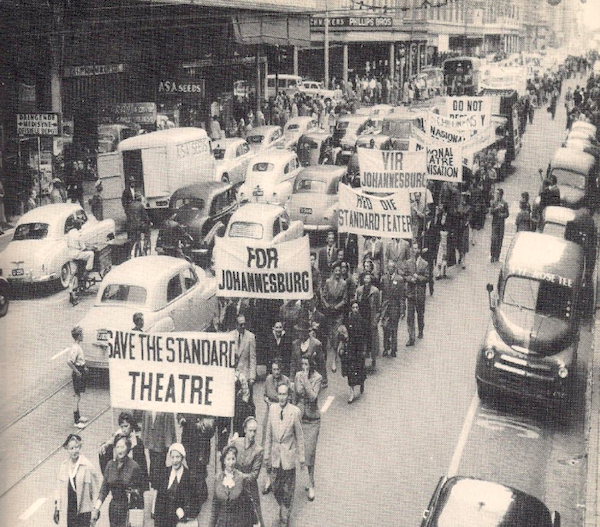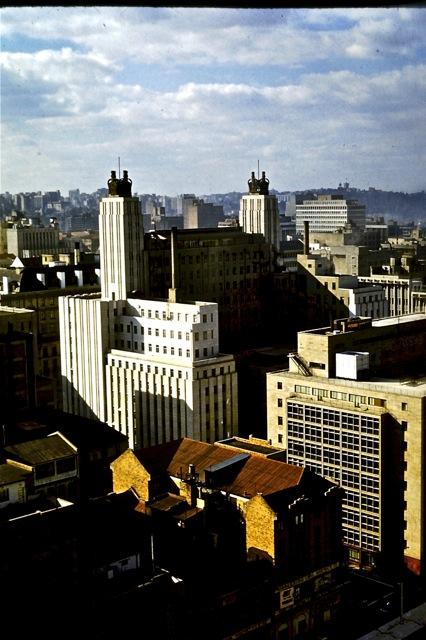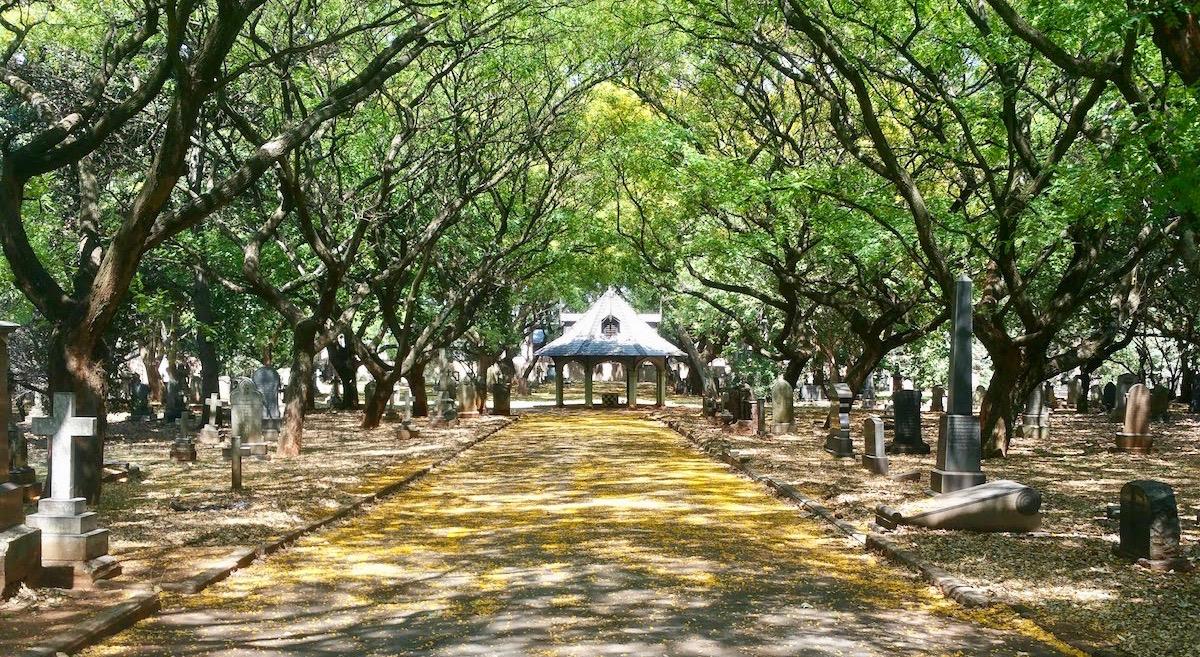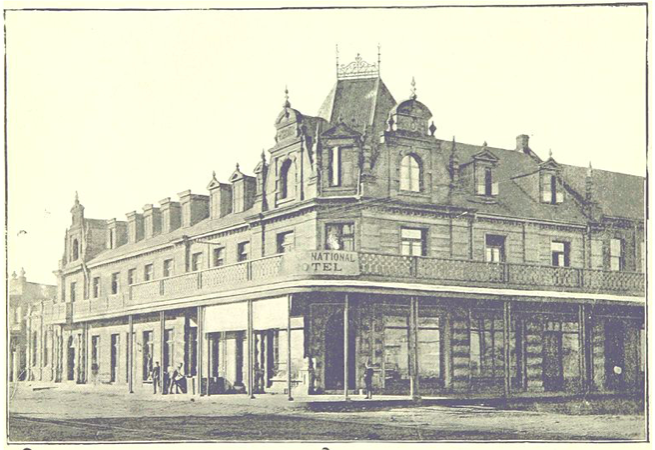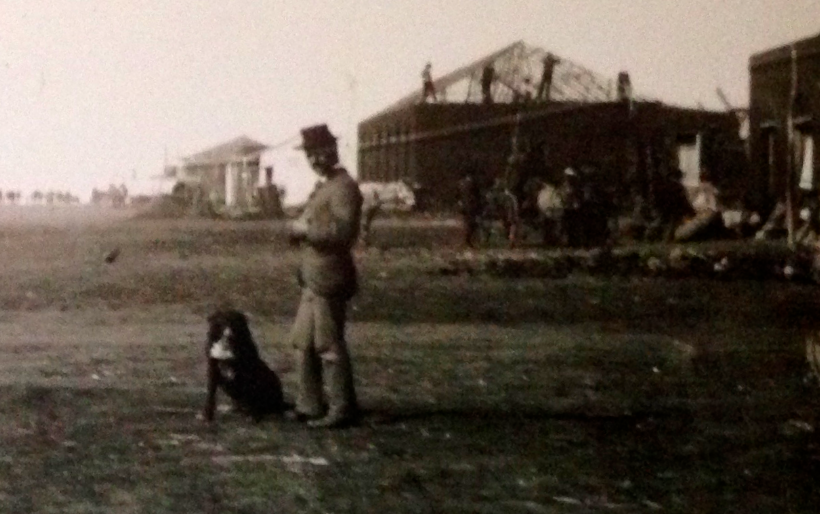
Disclaimer: Any views expressed by individuals and organisations are their own and do not in any way represent the views of The Heritage Portal. If you find any mistakes or historical inaccuracies, please contact the editor.
In the article below, journalist Lucille Davie uncovers some wonderful Joburg history. Read on for some of the city's fascinating 'firsts'. The piece was first published on 24 November 2003. Click here to view more of Davie's work.
Johannesburg is a modern city in every sense – tall skyscrapers, a complex network of freeways, a bustling metropolis of industry and commerce, and a hub to which people are drawn.
Joburg Skyline (The Heritage Portal)
It was declared a city in 1928 but life for Johannesburg began on 20 September 1886, when President Paul Kruger declared the area open for public digging, under the leadership of Carl von Brandis. The city grew quickly, from a tent town to wood and iron shacks, to brick buildings, within a decade or two.
Von Brandis Statue (The Heritage Portal)
The city kept pace with Paris and London in new developments towards the end of the 19th century – electric lighting, motor cars, telephones . . . Historian and former chief librarian of the city, Anna Smith, in Johannesburg Firsts, has painstakingly researched many of the city’s firsts. Here is a look at some of them.
The first electric street lamp was erected on the corner of Rissik and President streets in October 1895. Wright & Graves advertised something called “K boots” in the first electric sign, around 1905. The first gas lamp was erected on 17 November 1892 by the Johannesburg Lighting Company.
The first electric trams were introduced in March 1906, travelling from the town to Siemert Road in Doornfontein. These trams ran until March 1961 when they were discontinued.
Johannesburg's Last Tram (sourced by Les Pivnic)
The first car to be seen on the streets of the town a Benz Voiturette, used for advertising, and appearing in 1897. It was advertised in Standard & Diggers’ News:
“Wanderers’ Grounds, Wednesday, January 13, 1897, at 4pm sharp.
The rage and topic of all Europe
The MOTOR CAR, or noiseless carriage.
The first and only one in South Africa, will exhibit on the Wanderers’ Track . . . One exhibition only
Popular Admission price 2/-
Photographers free
Hess & Co, Proprietors”
The first telephone system came into being in September 1894, with around 200 subscribers. The hardware was imported from Paris, and came with the following instructions:
”I have been requested to point out that subscribers to the Telephone System should not wait for a return-bell after they have rung up the Central Station, by means of the black button on the instrument. When the latter has been pressed, the receiver should be taken from the hook and upon an enquiry from the Central, the name and number of the subscriber with whom connection is required, should be given. On the reply ‘Voorwaarts’ being heard, the receiver should be replaced on the hook, the white knob pressed and the return-bell awaited before taking the receiver down again . . .”
The first tracks for Johannesburg’s first train were laid in 1888 and the line from Joburg to Boksburg was opened in March 1890. It was called the Rand Tram. This line was extended to Springs in October 1890, and to Roodepoort in November 1890. The line from Cape Town reached Joburg in September 1892. The line to Pretoria opened in January 1893, to Maputo in November 1894 and to Durban in December 1895.
Jozi’s first road was created in 1889, from Ferreira’s Camp to Jeppestown, down a road that everyone knows – Commissioner Street. It was made by getting an ox wagon laden with stones to move up and down, dropping stones and making the road.
The first gold weighing 350oz was sent to Pietermaritzburg on 12 April 1887.
The first share transaction happened in a miner’s tent in Ferreira’s Camp. Smith doesn’t give the date but the first shares to be quoted at a stock exchange occurred on June 1887. From the tent business moved to Johannesburg’s first stock exchange: Donovans’ livery stables on the corner of Sauer and Commissioner streets, and then on to a brick building on Commissioner Street, with stained glass windows, tiled lavatories, 20 columns, a bar, offices and a front porch.
First Johannesburg Stock Exchange (Johannesburg Saga)
Joburg’s first slump occurred in 1891, as reported in the SA Mining Journal of 1912, brought about when all the alluvial gold had run dry, and serious capital was needed to mine below the surface.
The first bank to open in the town was the Standard Bank, opening on 11 October 1886, in a tent. From the tent it moved to a thatched cottage. The bank manager was DP Ross and the bank clerk was P Mynhardt. The building stood at the entrance to Ferreira and Worcester, at 185 Anderson Street.
Services like the delivery of letters took a little longer to get off the ground. Ten years after it was established, in 2 November 1896, 20 postmen were employed to deliver 3 000 letters. But it didn’t last. Three months later, in February 1897, the budget for £3 000 wasn’t approved, and the service was discontinued.
The first telegram to be sent happened on 27 April 1887, sent by JE Symons the telegraphist. To get around the issue of who was going to have the honour of sending the first telegram, Symons sent the first one himself.
Banquets, barber shop, pubs and brothels
President Kruger was much on the minds of the first mining magnates. He glared at them from Pretoria, wishing them away and resisting most of their requests. So in February 1887 they held a banquet for him, the first in the town. This was followed by an Irish banquet in March of the same year, on St Patrick’s Day.
Johannesburg in those early days was largely populated by men, and of course, they needed to have haircuts. George Meredith saw the gap – he opened the town’s first barber shop in Ferreira’s Camp.
And to cater for those men’s needs the town had a large number of pubs and brothels. The town’s first barmaid was Amanda Aquenza, employed by Mr Chas Brown in a bar in Ferreira’s Camp, the first saloon owner in the town. Here is an account of her eagerly-awaited arrival in the town, by EC Trelawney Ansell in I followed gold:
”I do not think that I shall ever forget the arrival of the first barmaid in Jo’burg. Word of her coming had got ahead of her. Tales were being spread of her wonderful beauty, the glorious clothes she wore, the very low cut of her bodices, etc. Special emphasis was also laid on how easily she bestowed her nightly favours – at a price.
”The day came when the coach was to arrive with this beauty of the bar. Crowds of the Jo’burg 'boys' were there to meet her. The coach arrived with the beauty seated inside. Cheer after cheer went up as she was carried shoulder high from the coach to the billiard room of the Central Hotel, there to be regaled with iced champagne.
”Then she was forced to stand on the billiard table – in clothing that today would be thought much over-dressed, but was then thought supremely naughty – in corsets and voluminous drawers edged with plenty of lace – and was sold to the highest bidder for the sum of £150, champagne flowing like water meanwhile and all laughing and enjoying the fun.”
The first brothel to be set up was run by an American Amazon called Montana Nell.
Brewery and jail
It didn’t take long for the first brewery to be established: in 1887 the Wiltshire Brewery was set up at Ophirton, just north of Booysens.
And talking men and pubs and the inevitable brawls, the first jail was in Commissioner Street, opened in the same month as the town was established, built of brick with thatched roof. A later jail was built on the site of the present Drill Hall, on the corner of Twist and Plein Streets. The first jailer was Mr C Brahn.
Old photo of the Drill Hall
The first company of the Zuid Afrikaanse Republieke Polisie was composed of 16 men, formed on 12 November 1886, in the precinct stretching from Boksburg to Krugersdorp.
Sport and culture
Those early diggers were keen on sport: the first baseball match was played on Sunday, 10 February 1895, between Simmer and Primrose and City and Robinson. The first bicycle track race took place on 26 October 1889. The first cricket club was formed in November 1886, just two months after the town was established. The first match was won in a test against Britain, in 1906.
The first Association Football Club was the Alpha, formed in 1887. The golfers didn’t take long to get it together: on 4 November 1890 the first golf club was formed. Women got their act together with hockey, establishing the first hockey club for women in 1903/4, and the first hockey test was played in 1925, against England.
Ice-skaters were on the ice in 1910, when the first ice-skating rink, called Niagara, was opened near Park Station. The first roller skating rink was opened in February 1891 in Kerk Street.
Cultural activities were not forgotten: the first chess club was set up in 1891, with Lord Randolph Churchill the first president of the Johannesburg Chess Club. The town’s first concert was held on 21 June 1887, put on by the International Order of Good Templars, to mark the Golden Jubilee of Queen Victoria. It took place in Thompson’s Store in President Street, where The Star is today.
On 13 October 1891, Sir Dan Godfrey was the first conductor in the country to use a baton only to conduct an orchestra, instead of playing the piano with one hand and conducting with the other. This wonder happened at the Standard Theatre.
Protests to save the Standard Theatre in the 1950s (Lost Johannesburg)
If circuses can be called culture, the first circus to hit town was Fillis’s Circus, set up in Ferreira’s Camp in September 1886, barely weeks after the town came into being.
Do flower shows fall under culture? Well, if they do, the first flower show was held in the Wesleyan Church in February 1893.
First buildings
It is believed that the first tent went up on 9 July 1886, two months before the gold diggings were declared. It belonged to J Paxton De Roi.
The first building of any consequence was the Central Hotel, in Ferreira’s Camp, made of wood. Later, when Randjeslaagte (a triangle of left-over farm land) was proclaimed as the new town, FH Bussey, the owner of Central Hotel, built a new hotel on the corner of Commissioner and Sauer streets, of stone quarried from Doornfontein.
Shops sprung up quite quickly: in 1886 the first chemist was opened in Commissioner Street by a Mr Heymann, called the Golden Mortar Dispensary. The first café, the Café Francais, was in Ferreira’s Camp, on the corner of Market and Joubert streets.
Perhaps Café Francais sold some of the first chewing gum in the town – in 1895 Beeman’s Pepsin Chewing Gum was sold, introduced by AA Officer.
The first school was opened in Ferreira’s camp in November 1886, just two months after the town was started. There were 14 pupils, and H Duff was the teacher. He managed to build a schoolhouse, which, he says, “though unpretentious, yet sufficient for the purpose, at least until some more definiteness be attained in the population and that fixity which will encourage the people to provide a permanent place for the instruction of youth”. He goes on to say that the cost of the building was £7.10 plus £14 for furnishings, an amount he thought was “perhaps not without reason that this was a public matter I have started a subscription to defray the deficit”.
The first church building to go up was the Methodist Church in 1887, on the site of the present-day His Majesty’s Theatre, in Commissioner Street.
His Majesty's Building (Gordon Clarke)
The first hospital was located on the corner of Simmonds and Main streets. It’s not known when it was built.
The first female office worker was Miss Letty Impey (later Mrs Tandy), who, in around 1894 worked for the solicitor Henry Lindsay. She knew shorthand and sat is Lindsay’s office boy’s office with a screen around her for privacy as it was not “quite proper” to be seen. Smith says that “every man in Johannesburg came and looked behind the screen”.
First cemeteries
The first two cemeteries to serve the town were Braamfontein and Brixton, both now full. Before they were established, a makeshift cemetery was laid out in the town centre, on the corner of Harrison and Bree streets, and as the town grew, these corpses were exhumed and re-buried in Braamfontein Cemetery, established in 1887.
Braamfontein Cemetery (The Heritage Portal)
The first person buried in town was Mary Dearlove, who died on 29 March 1887, at the age of 45. Her nephew, J Dearlove Hardy, a transport rider, recalls the event in The Sunday Times of 23 April, 1911:
”It was in March 1887 that I dug the first grave on the Rand. My Aunt Mrs Mary Dearlove fell ill . . . I outspanned on what is now Market Square and let the oxen graze there whilst I walked up to where my Aunt lay ill in a tent. There were two doctors in attendance, a German and an Englishman who had come with the rush.
“But they could not save her, and I had to go to Captain von Brandis and asked him where they buried people. He said he did not know if there was a place, but he would send a man with me to point out a plot for a Cemetery. I had the first grave marked out and my boys dug it.
”A Carpenter friend of mine John Malzer helped with the Coffin; but the nearest Minister was in Pretoria. We sent to Pretoria but there was no conveyance available, and a Mr Rens officiated at the graveside reading the burial service. As we got back from the Cemetery a Wesleyan minister turned up.”
The first census was held on 2 April 1890, when the town was four years old, and being South Africa, only whites were recorded: 119 128.
First dog and cat
The first dog to appear in the town was a fox terrier, owned by Dr GJM Melle and obtained in April 1887. Its name was Whiskey. Isobel Solomon brought the first cat into town from the Cape, date unknown.
Johannesburgers had to deal with the big swarm of locusts in May 1891. The Star of 1936 reported that the “first big swarm of locusts descended on Johannesburg on 28 May 1891. One walks upon locusts; the walls are barnacled with them; but still they come, and there are at present no indications of them going away . . . Even the fires that were thought to be efficacious in warding off their attacks seem to be utterly despised, and there is nothing for it, since they are uninvited guests, but to wait their pleasure in going away”.
The first pet shop opened in a tearoom which was opened in 1900, on the corner of Noord and Harrison streets.
First movie
The first moving picture shown in South Africa was at the Grand National Hotel in Johannesburg on 4 April 1895. They were also shown in Henwood’s Arcade, between Pritchard and President streets. The new Apollo Theatre in Pritchard Street showed moving pictures, and the first bio-cafes were opened in the city in 1912.
Grand National Hotel (Longlands Directory)
Weather
The city’s first snow fall occurred on 16 May 1891, a Saturday morning.
Those pioneers must have felt the heat. The first swimming bath was opened in Fordsburg in April 1888. Smith says: “Numbers will be limited and gentlemen should record their names. Also arrangements for ladies.”
Joburg has come a long way.
Main image: Joburg's First Dog (Johannesburg Firsts Exhibition - Museum Africa)
Lucille Davie has for many years written about South Africa's people and places, as well as the country's history and heritage. Take a look at lucilledavie.co.za
Comments will load below. If for any reason none appear click here for some troubleshooting tips. If you would like to post a comment and need instructions click here.

